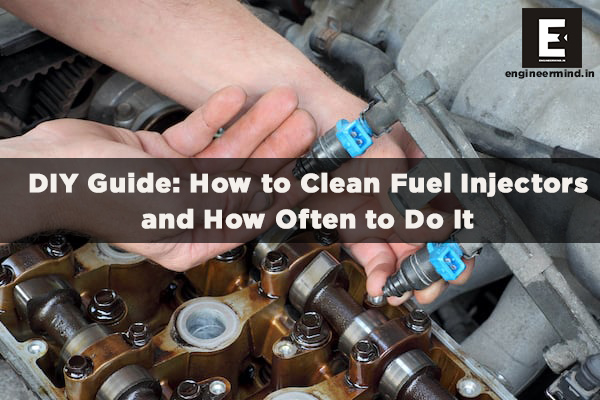Fuel injectors are vital components that contribute significantly to the efficient functioning of your car’s engine. However, as time passes, these injectors can accumulate dirt, debris, and carbon deposits, resulting in diminished performance, decreased fuel efficiency, and the possibility of engine misfires. To maintain your vehicle’s optimal performance and prolong its lifespan, it is crucial to regularly clean fuel injectors. In this article, we will provide you with a comprehensive guide on how to clean fuel injectors in the comfort of your own home, enabling you to save both time and money.

Table of Contents
What is a fuel injector?
A fuel injector is a device responsible for delivering fuel to the internal combustion engine of a vehicle. It is typically located in the engine bay, near the throttle body or intake manifold, and is connected to the fuel rail. The fuel injectors work by spraying a fine fuel mist into the engine’s intake manifold or the combustion chamber.
Fuel injectors are controlled by the engine control module (ECM), which receives input from sensors such as the throttle position sensor, mass airflow sensor, and oxygen sensor. The ECM uses this input to determine the fuel needed to be delivered to the engine. The injectors then spray fuel into the machine in precise amounts at specific intervals. This allows the engine to run smoothly and efficiently by providing the right fuel for the current driving conditions.
Injectors are commonly used in gasoline-powered vehicles but can also be found in diesel and alternative fuel engines. There are different types of fuel injectors, such as Multi-Port Fuel Injectors (MPFI), Throttle Body Injectors (TBI), and Direct Injection (DI), and each has its advantages and disadvantages based on the engine design and application.
Importance of Clean Fuel Injectors
Clean fuel injectors are vital for maintaining proper fuel atomization and distribution in the engine. When the injectors are clogged, the fuel spray pattern is disrupted, resulting in incomplete combustion and decreased power. Additionally, dirty injectors can lead to a buildup of harmful deposits on the intake valves and combustion chambers, affecting engine performance further.
Signs of Dirty Fuel Injectors
Identifying the signs of dirty fuel injectors is crucial for timely maintenance. Some common symptoms include rough idling, reduced acceleration, decreased fuel efficiency, engine misfires, and even the presence of black smoke from the exhaust. If you notice any of these issues, it’s likely that your fuel injectors need cleaning.
Benefits of Cleaning Fuel Injectors
- Improved Fuel Efficiency:
- Clean fuel injectors ensure a proper fuel spray pattern, optimizing fuel combustion and reducing fuel waste.
- Enhanced Performance:
- By restoring the proper fuel flow, cleaning fuel injectors can improve engine power and throttle response.
- Prevented Engine Damage:
- Clogged fuel injectors can cause engine misfires and lead to long-term damage if left untreated. Regular cleaning helps prevent such issues.
- Lower Emissions:
- Clean injectors contribute to reduced emissions, benefiting both the environment and your vehicle’s compliance with emission standards.
DIY Methods for Cleaning Fuel Injectors
Method 1: Using Fuel Injector Cleaner Additives
Fuel injector cleaner additives are readily available at automotive stores and can be a convenient way to clean injectors. Simply pour the recommended amount into your fuel tank during a full tank refill. As you drive, the additive will clean the injectors by removing deposits and improving fuel flow.
Method 2: Using a Cleaning Kit
Fuel injector cleaning kits are designed specifically for this purpose and often provide more thorough results. The kit typically includes a canister containing a cleaning solution, hoses, and connectors. By following the instructions provided with the kit, you can connect the canister to the fuel rail and run the engine to clean the injectors effectively.
Method 3: Ultrasonic Cleaning
For a more advanced cleaning method, consider ultrasonic cleaning. This technique involves using an ultrasonic cleaner that generates high-frequency sound waves to agitate a cleaning solution. By immersing the fuel injectors in the solution and subjecting them to ultrasonic vibrations, stubborn deposits are loosened and removed.
Precautions to Take Before Cleaning Fuel Injectors
- Refer to the Vehicle Manual:
- Familiarize yourself with the specific fuel injector cleaning recommendations provided by the vehicle manufacturer.
- Safety First:
- Ensure the engine is cool and the ignition is turned off before working on the fuel system. Disconnect the battery to prevent accidental starts.
- Protective Gear:
- Wear gloves, safety glasses, and work in a well-ventilated area to protect yourself from fuel and cleaning chemicals.
- Use Recommended Products:
- Always use fuel injector cleaning additives or kits that are compatible with your vehicle’s make and model.
Step-by-Step Guide to Cleaning Fuel Injectors
Step 1: Gather the Necessary Tools and Supplies
Before starting the cleaning process, gather the required tools and supplies. This may include a fuel injector cleaner additive or a cleaning kit, a fuel pressure gauge, a socket set, cleaning brushes, and lint-free cloths.
Step 2: Locate the Fuel Injectors
Refer to your vehicle manual to locate the fuel injectors. They are typically attached to the fuel rail and positioned near the intake manifold.
Step 3: Disconnect the Fuel Injector Rail
Using a fuel pressure gauge, relieve the fuel pressure by following the manufacturer’s instructions. Once the pressure is released, disconnect the fuel injector rail from the fuel line and carefully remove any electrical connectors or retaining clips.
Step 4: Remove the Fuel Injectors
With the fuel rail disconnected, remove the fuel injectors one by one. Use a socket set or appropriate tools to carefully loosen and detach each injector from the intake manifold.
Step 5: Clean the Fuel Injectors
Depending on the method chosen, follow the instructions provided with the fuel injector cleaner additive, cleaning kit, or ultrasonic cleaner. Ensure that you thoroughly clean each injector and remove any deposits or buildup.
Step 6: Reinstall the Fuel Injectors
Once the fuel injectors are cleaned and dried, carefully reinstall them into the intake manifold. Make sure to use new O-rings or gaskets if necessary.
Step 7: Reconnect the Fuel Injector Rail
Reconnect the fuel injector rail to the fuel line, ensuring all electrical connectors and retaining clips are properly secured.
Step 8: Test the Fuel System
Turn on the ignition and listen for any unusual noises or fuel leaks. Start the engine and check for proper idle, smooth acceleration, and improved performance. Monitor the vehicle’s performance over time to ensure the cleaning was successful.
Professional Fuel Injectors Cleaning
While DIY methods can be effective, professional fuel injector cleaning services are also available. These services use specialized equipment and cleaning solutions to thoroughly clean and restore fuel injectors. If you’re unsure about performing the cleaning yourself or prefer expert assistance, consider seeking professional help.
Conclusion
Regularly cleaning your fuel injectors is essential for maintaining optimal engine performance, fuel efficiency, and longevity. By following the step-by-step guide provided in this article, you can confidently clean your fuel injectors at home, saving time and money. Remember to take necessary precautions, use recommended products, and monitor your vehicle’s performance after cleaning. Enjoy the benefits of clean fuel injectors and experience a smoother and more efficient drive.







